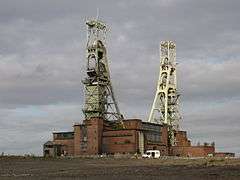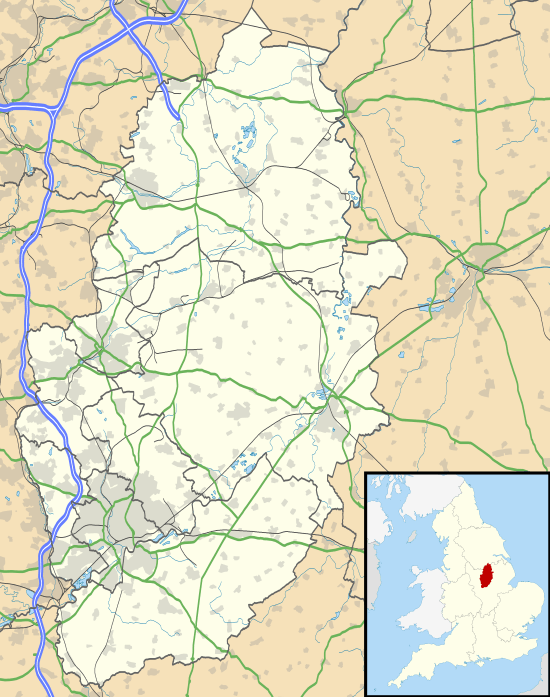Clipstone
Clipstone in north Nottinghamshire is a small ex-coal mining village built on the site of an old army base and likely the site of a medieval royal palace. The population of the civil parish was 3,469 at the 2001 census, increasing to 4,665 at the 2011 census.[2]
| Clipstone | |
|---|---|
 Clipstone Colliery disused headstocks | |
 Clipstone Location within Nottinghamshire | |
| Population | 3,469 (2001 census[1]) |
| OS grid reference | SK585635 |
| District | |
| Shire county | |
| Region | |
| Country | England |
| Sovereign state | United Kingdom |
| Post town | MANSFIELD |
| Postcode district | NG21 |
| Dialling code | 01623 |
| Police | Nottinghamshire |
| Fire | Nottinghamshire |
| Ambulance | East Midlands |
| UK Parliament | |
History
King's Clipstone is a small village in north-west Nottinghamshire. The earliest historical reference to the settlement is in the Domesday Book of 1086, where the village is mentioned as "Clipestune".[3] Subsequent written sources use the forms "Clipestone", "Clippeston", "Clipiston". The place-name Clipstone seems to contain an Old Norse personal name, Klyppr, with tun (Old English), an enclosure or farmstead, so 'Klyppr's farm or settlement'.[4][5][6]
Pre-historic period
The earliest date-able material from Clipstone is from the Bronze Age. These pieces of material were a spearhead[7] and an arrowhead.[8] There is also a suspected ring ditch in the vicinity of New Clipstone which is assumed to be a ploughed out round barrow.[9]
The National Mapping Project data as provided by English Heritage shows a number of cropmarks recorded from aerial photography in the northern quarter of Clipstone parish, representing rectilinear field systems associated with smaller stock enclosures and perhaps domestic sites. Typologically, and from their orientation, it is assumed that these are part of the brickwork plan field system from the late Iron Age, which stretches across the Sherwood Sandstones.[10]
Roman period
Pottery of the period is known from Clipstone due to Philip Rahtz's excavation in 1956[11] and Trent and Peak Archaeology's watching brief and fieldwalking in 1991,[12] however the context of the finds has never been understood. There have also been metal detector finds within the parish of two Roman brooches and a small coin hoard[7] and arrowhead.[13] The adjacent parish of Mansield Woodhouse contains a suspected Roman road (Leeming Lane), with an associated marching camp at Roman Bank. Further to the north-west a small villa site was exposed in 1780 by the antiquarian Major Hayman Rooke.[14]
Early Medieval period
Four pieces of late Saxon shelly ware pottery were recorded in 1991[12] during fieldwalking of Castlefield, although it is unlikely that these represent anything more than a background scatter associated with the manuring of the open fields. These four pieces of pottery are actually Potterhanworth Ware, dating to the 13th–15th century[15] Prior to Domesday, the two manors of Clipstone were held by Osbern and Ulsi and the value was set at 60 shillings (£3).[3] Ulsi in particular was a reasonably wealthy landowner and held manors at Greasley, Strelley, Sutton and Hodsock.
Domesday
The landowner in 1086 was Roger de Busli,[3] one of the great Norman landowners who held 163 estates in Nottinghamshire, Derbyshire and south Yorkshire.[16]
King John's Palace
While there is no conclusive proof of the medieval royal residence being built by King John, there were known to be 1400 acres of forested deer park (and 70 acres of rabbit warrens) next to the village, which were used by royal hunting parties. Moreover, it is said that King John held a parliament at the nearby Parliament Oak in 1212, and also Edward I in 1290.[17]
Industrialisation
George Sitwell, ironmaster mined iron locally and built a furnace here in the 17th century.[18]
Clipstone Riot 1767
In 1767 much of the local forest was managed by the Duke of Portland for the production of timber. In the 1760s there were a number of prosecutions of local people for entering the forest park and causing disorders. In 1767 labourers from Warsop and Worksop were involved in the Clipstone Riot. As the Duke of Portland was at the time involved in making the place more profitable for himself, and so impacting on the timber rights of the commoners, this may have been the cause of the riots.[19]
General description
Clipstone is split into two areas – New Clipstone, approximately four miles from Mansfield town, and Kings Clipstone slightly further away, formerly known as Old Clipstone until 2003 when the ancient name of Kings Clipstone was resurrected.[20][21] Both settlements lie alongside the B6030 road.
New Clipstone (commonly known as just 'Clipstone') is the most diverse area with both old and new homes, a library, primary school and village hall as well as a few shops and pubs, including Clipstone Welfare, which was used for scenes in the 2007 film Control. The old Clipstone Colliery site lies within the New Clipstone area, still having the tall prominent headstocks.
On the southern edge of the village is Vicar Water Country Park, developed from Vicar Water and the former spoil tips from the colliery, forming a landscape of hills and ponds with a controversial 'Golden Hand' sculpture, said to represent the village's mining heritage.
Most of the village is within Newark and Sherwood district council area, with a small section in the west near Forest Town in the Mansfield council area. The Garibaldi College is just inside Mansfield district. A large modern housing development close to New Clipstone but previously considered as part of 'Old Clipstone'/Kings Clipstone was reclassified as being in Clipstone after a boundary realignment in late 2009.[22]
The local football team is Clipstone Welfare. The village is close to Sherwood Forest. Nearby is the medium-wave transmitter for Radio Nottingham. There is also a slaughterhouse.
Kings Clipstone (previously known as Old Clipstone) is the oldest part in a rural setting with some old stone buildings, noted for its relatively 'undeveloped' character. The local Dog and Duck pub is the only social place to meet.
Clipstone Camp
Located on what was to become Clipstone Colliery, Clipstone Camp was established when work on developing the mine, started in 1912, was abandoned following the outbreak of the First World War. The Duke of Portland offered the land for use as a military training camp, which was eventually opened in 1915.[23] The first troops stationed there were the Royal Fusiliers. At its height the camp could accommodate 30,000 soldiers.[23]
Following the armistice troops from the Queens Royal West Surrey 4th/5th Reserve Battalion and the York and Lancaster Regiment were involved in a mutinous riot at the camp, following disquiet at the slow rate of being demobilised.[24]
Plans were started in 2013 to provide a memorial to those who trained in Clipstone.[25]
Clipstone Colliery
The pit closed in April 2003. Since 1993 it had been owned by RJB Mining (now UK Coal). The present headstocks, Grade Two listed structures, were at the time of completion in 1953 the tallest in Europe.[26] They can be seen from miles around. Despite this, there has been a number of attempts by owners Welbeck Estates to demolish them due to the expense of the upkeep.[27] During September 2014, an epetition was submitted to the British government, to raise public support and awareness, which ran until March 2015.[28]
Clipstone Colliery Sidings railway station was the station in Clipstone, Nottinghamshire that served the mine[29]
King John's Palace
King John's Palace is the ruined walls of a former medieval royal residence previously used for hunting trips into Sherwood Forest near to Old Clipstone. The ruin appeared on an episode of the archaeological TV show Time Team.
References
- "Parish Headcounts: Clipstone CP". Neighbourhood Statistics. Office for National Statistics. Retrieved 15 April 2007.
- "Civil Parish population 2011". Neighbourhood Statistics. Office for National Statistics. Retrieved 7 April 2016.
- Morris, J., ed. (1977). Domesday Book: Nottinghamshire. p. 285.
- Gover, J. E. B.; Mawer, A. & Stenton, F. M., eds. (1940). The place-names of Nottinghamshire. English Place-Name Society. 17. Cambridge: Cambridge University Press. p. 232.
- Mills, A. D. (2002). A Dictionary of English Place-Names. Oxford: Oxford University Press. p. 120. ISBN 978-0-19852-758-9.
- Ekwall, Eilert (1960). Concise Oxford Dictionary of English Place-names (4th ed.). Oxford: Oxford University Press. p. 112.
- Nottinghamshire Historic Environment Record, 5965
- Nottinghamshire Historic Environment Record, 5909
- Nottinghamshire Historic Environment Record, 6819
- Historic England. "Monument No. 1430560". PastScape. Retrieved 12 September 2011.
- Rahtz (1960), p. 29.
- Sheppard, R., (1991) Unpublished archive of archaeological watching brief prior to monument underpinning (Held by Nottinghamshire County Council)
- Nottinghamshire Historic Environment Record, 5966 & 5977
- Thoroton (1972), pp. 308–320.
- Budge, David (2014). Challis, Keith (ed.). "Clipstone, King John's Palace". Transactions of the Thoroton Society. 118: 18. ISSN 0309-9210.
- Wright, James (2008). Castles of Nottinghamshire. Nottingham: Nottinghamshire County Council. ISBN 978-0-90275-158-3.
- Country Life. (at Google books). 1913. p. 53.
- Riden, Philip (2004). "Sitwell, George (bap. 1601, d. 1667)". Oxford Dictionary of National Biography. Oxford University Press. Retrieved 2 March 2010.
- Agnoletti, Mauro; Anderson, S. (2000). Forest History: International Studies on Socioeconomic and Forest Ecosystem Change (IUFRO Research. CABI Publishing. ISBN 0851994199.
- "A brief history of Kings Clipstone". Newark and Sherwood District Council. Archived from the original on 18 October 2014. Retrieved 11 September 2014.
- "Village Council of Kings Clipstone". Newark and Sherwood District Council. Archived from the original on 18 October 2014. Retrieved 11 September 2014.
- "Clipstone boundary change confusion". Mansfield & Ashfield Chad. 19 January 2010. Retrieved 11 September 2014.
- "Clipstone Camp at Mansfield Museum". Our Mansfield Area. Retrieved 13 January 2016.
- Whatling, Frank Henry. "Frank Henry Whatling Memoirs". Great War Forum. Archived from the original on 2 December 2013. Retrieved 26 November 2013.
- Thirkill, Stephen (26 July 2013). "Clipstone Camp war memorial plans move a step nearer". Mansfield & Ashfield Chad. Retrieved 4 January 2014.
- Historic England. "Headstocks and Powerhouse at the site of the former Clipstone Colliery (1380235)". National Heritage List for England. Retrieved 22 September 2014.
- "New plan for Clipstone Headstocks". Mansfield & Ashfield Chad. 15 March 2014. Retrieved 22 September 2014.
- "Save Clipstone Colliery headstocks". epetitions. 10 September 2014. Archived from the original on 24 September 2014. Retrieved 22 September 2014.
- "Rail Chronology : East of Mansfield".
External links
| Wikimedia Commons has media related to Clipstone. |